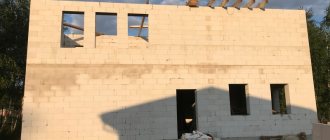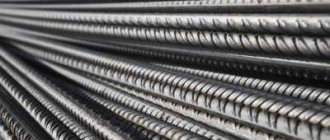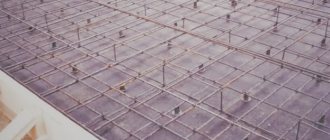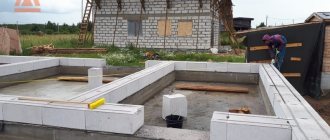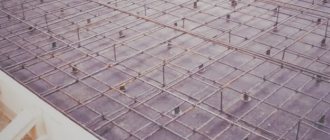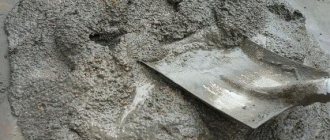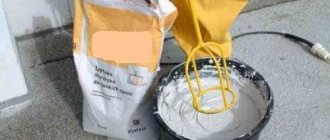The reinforcement bars connected to each other form a reinforcing frame, which serves as the “skeleton” of the reinforced concrete structure. The most common material used to connect rods is wire. Calculations of its consumption should be carried out individually for each reinforced structure.
Two types of wire
Knitting wire is produced from metal blanks by drawing. There are two main types of knitting wire: regular tinned and fired. To tie reinforcement in foundations and other reinforced concrete structures, the second type is used.
To prepare the wire, it is treated with thermal hardening, which gives it flexibility and resistance to the harmful effects of the environment, and also makes it less plastic, which greatly increases the strength of the material and, consequently, the wire assembly.
Stores offer galvanized and non-galvanized material. Both can be used to tie reinforcement, although galvanized binding wire (GOST) will be more resistant to aggressive environments.
This is interesting: Consumption of reinforcement per 1 m3 of concrete - how to calculate
Labeling and classification
All produced knitting wire is manufactured in accordance with GOST – 3282-74 “Low-carbon steel wire for general purpose”. The document regulates all technical characteristics - type, dimensions, manufacturing accuracy, mechanical properties of the material.
GOST specifies the classification of wire according to the following criteria:
- By type of processing - heat-treated or not.
- Depending on the type of coating - with or without galvanized coating.
- In terms of manufacturing accuracy - with increased or normal accuracy.
- According to temporary tensile strength (only for non-annealed) – groups I and II.
Depending on the conditions under which the heat treatment was carried out, the wire can be light or black. Black is obtained by annealing in air; under the influence of oxygen, oxides and scales are formed on the surface of the metal. The light one undergoes heat treatment in an environment of inert gases, its surface is clean, but in terms of technological parameters it is no different from the black one.
Wire can be produced with a diameter from 0.16 to 10 mm without coating, and 0.2 – 6 mm with coating.
A coil of the most popular galvanized binding wire with a diameter of 1.2 mm, weighing 25 kg.
Wire markings include:
- diameter – indicated in millimeters;
- type of treatment – letter O, in case of heat treatment;
- manufacturing accuracy - letter P with increased accuracy;
- surface type – C (light), B (Black)
- presence of zinc coating - 1C or 2C (the number indicates the class).
All produced wire is wound onto coils or spools, undergoes mandatory control, is marked and confirmed with a quality certificate. The products required for use are selected based on the labeling. Each type of knitting “thread” has its own purpose based on the conditions of its use.
Purpose of hardware
Wire for connecting reinforcement plays a key role in the construction of monolithic concrete structures. The main purpose of this material is to link reinforcing elements into a spatial or flat frame. This type of product is used for the production of:
- chain-link mesh;
- ropes;
- masonry mesh;
- prickly hardware;
- to carry out packaging work.
Use of wire for tying reinforcement
This is interesting: A500C reinforcement assortment table
Methods for determining the required wire mass
To purchase metal products, you need to convert the resulting footage into kilograms. To do this, you can use an online calculator or table.
Table of mass of 1 m of binding wire of various diameters
| Diameter, mm | Weight 1 m, kg | Footage 1 kg, m |
| 0,6 | 0,00222 | 450,45 |
| 0,8 | 0,00395 | 253,17 |
| 1,0 | 0,00617 | 162,0 |
| 1,2 | 0,00888 | 112,6 |
| 1,4 | 0,0121 | 82,6 |
| 1,6 | 0,0153 | 65,4 |
| 1,8 | 0,02 | 50,0 |
| 2,0 | 0,0247 | 40,5 |
The minimum weight of wire products in coils and coils put on sale must comply with GOST 3282-74
| Wire diameter, mm | Minimum weight of wire in a coil or on a reel, kg | |
| Without cover | Zinc plated | |
| Up to 0.2 | 1 | — |
| 0,2-0, 6 | 2 | 0,3 |
| 0,6-1,0 | 5 | 0,6 |
| 1,0-2,0 | 8 | 2,0 |
| 2,2-3,6 | 12 | 5,0 |
| 4,0-46,0 | 30 | 10,0 |
| 6,3-10,0 | 40 | — |
The maximum weight of hardware in a coil is 1500 kg. Each skein should consist of only one piece.
Concrete consumption in the manufacture of various structures: calculations and standards
As a rule, calculations of concrete solution costs are contained in the design documentation. However, if you are building your house, outbuilding and other buildings yourself, then you will have to carry out the calculations yourself. The cost of concrete work depends on their correctness.
Concrete costs depend on the type of structure being made.
How to make calculations for the foundation of a house
The amount of concrete costs depends on the type of foundation chosen.
Slab base
Such a foundation is a monolithic slab, poured under the entire house.
In this case, you need to know the area of the building and the thickness of the base.
- Let's give an example. It is necessary to pour a slab foundation, 10 cm (0.1 m) thick, under the house, measuring 9 × 9 m.
- The area of the slab is: 9∙9=81 m2.
- We calculate the filling volume: 81∙1=8.1 m3. Calculations for concrete screed are carried out in the same way.
This instruction did not take into account the stiffening ribs at the bottom of the foundation, which ensure its stability and rigidity.
They intersect and break the base into squares.
- For a 9x9 m foundation, ribs must be laid every 3 m.
- Their thickness is equal to the thickness of the slab itself, in our case it is 10 cm.
- The total number of ribs is 6 (3 across and 3 along), the length of each of them is 9 m.
- Consequently, their total length is 54 m. With a width and height of the ribs of 0.1 m, their volume is: 54∙1∙0.1=0.54 m3.
We add both numbers and get the result - 8.64 m3 of solution.
Tape base
Tape base.
The rate of concrete consumption per 1 m3 of such a foundation is also calculated simply.
For this purpose, you need to know the width, length, depth and height of the ground part of the base.
- Our example will be the same building with sides measuring 9 × 9 m. Its perimeter is 9 ∙ 4 = 36 m. Let the width of the base be 40 cm (0.4 m), the depth of 1 m, and the ground part 50 cm (0.5 m).
- In other words, the total height of the base is 1+0.5=1.5 m.
- We calculate the volume of the foundation: 36∙4∙1.5=21.6 m3.
Note! This calculation does not take into account partitions.
If they are in the project, you should sum up the volume of tapes for them and the volume of the main foundation.
Columnar foundation
Parameters taken into account during calculations.
To determine the cost of concrete for arranging such a foundation, you need to know the number, height and cross-section of the supports.
First, the mixture consumption per column is calculated, then the figure is multiplied by their number.
- When calculating the area of a support with a circular cross-section, the formula S=3.14∙R∙ is used. The letters mean: S is the required area, and R is the radius of the section.
- If the pillars are rectangular in shape, the area is calculated by multiplying their two adjacent sides.
- When the area of the support is found, it should be multiplied by the height of the supports and their number. This way you will find the volume of concrete you need.
Reinforcement consumption
The reinforcement is counted by determining its total length.
When pouring a structure with a reinforced frame, you should also calculate the cost of materials for it.
Twig frame
To calculate the frame, you just need to measure the entire length of the reinforcement.
The consumption of binding wire per 1 m3 of concrete is determined as follows.
- First, the connection method is determined. It can be like this: the transverse and longitudinal rods of the lower belt are fixed, then vertical rods are screwed to them. And the transverse and longitudinal reinforcement of the upper chord is already fixed to them.
- This means that at the intersection points of two horizontal and one vertical rods there will be 2 wire connections.
- To tie one intersection point of the reinforcement, 15 cm of tying wire is required. At the same time, it folds in half, therefore, it needs 30 cm for one connection.
Volumetric reinforcement
Volumetric reinforcement using fiber fibers is being used more and more widely. Unlike metal analogues, they are distributed evenly throughout the solution, increasing its astringent qualities and resistance to delamination.
Fiber consumption per 1m3 of concrete is given in the table.
| Area of use | Desired fiber size, in mm | Material consumption |
| Industrial types of floors | 12 and 20 | 0.6 kg/1 m3 - to avoid the formation of cracks during shrinkage. 0.9 kg/1 m3 - to increase the strength of concrete. |
| Concrete and reinforced concrete structures | 12 and 20 | 0.6 kg/1 m3 - to prevent cracking during hardening. 0.9 kg/1 m3 - to increase the strength of structures and avoid cracks. |
| Cellular types of concrete (foam concrete and non-autoclaved aerated concrete) | 12, as well as 20 and 40 | from 0.6 kg/1 m3, based on the required strength of the product. |
Waterproofing
Deep penetration waterproofing compounds are often used for concrete structures.
Note! For example, the consumption of Penetron per 1 m3 of concrete is not so great, but it prevents the penetration of moisture through the base.
In addition, the composition increases the strength and frost resistance of concrete.
This waterproofing is available in dry form. It consists of special cement, finely ground quartz sand and active chemical additives.
Penetron consumption per 1 m2 of concrete varies from 0.8 to 1.2 kg, which depends on the degree of roughness of the base.
Standards applied in production
The photo shows the consumption of materials for different factory-made concretes.
Concrete consumption rates in production are applied in accordance with the requirements of State Standard No. 14.322/83.
They reflect the maximum volume of solution that can be used to produce units of products or work. When drawing up standards, technologists take into account the useful consumption of material, its losses and waste. Based on them, the price of the products is determined.
In factories, the required volume of mixture for the production of a certain product is found by calculation or graphic-analytical method.
- The calculation method uses drawings and technical documentation. The consumption coefficient of concrete during its compaction is also taken into account.
- With the graphic-analytical method, real material costs are compared with protocol figures. Next, graphs are made and analyzed by computer programs.
Conclusion
It is extremely important to know the exact cost of the solution when carrying out work, be it the consumption of aerated concrete blocks per 1 m2 or mixtures for monolithic structures. This determines how you organize the construction process.
The video in this article will give you more food for thought.
Page 2
The drying time of concrete (or, to be precise, the time it takes to gain strength) is precisely the factor that significantly slows down any construction. And the main difficulty in this case is the fact that reducing this time can only be achieved by carrying out rather complex and costly activities.
Below we will describe what happens to the solution when it dries, and also provide a number of recommendations for optimizing this process.
Adjusting the moisture content of the material is an important factor in ensuring its performance
Drying concrete correctly
Main stages
Until the solution has set, it can be leveled
To understand how to dry concrete as quickly as possible and without loss of quality, you need to understand what happens inside the solution itself after pouring. If you do not take into account the chemical component (it is of interest only to professionals), then several stages can be roughly distinguished. For ease of analysis, we have compiled them into a single table:
| Stage | What's happening? |
| Grasping | As soon as we poured the solution into the formwork or mold (if we were not quick enough, then in the trough or container of the concrete mixer), the cement begins to react with water. In this case, primary hydration of the most active components occurs, and polymerization of part of the material occurs. As a rule, this process takes from 30 minutes to several hours. During this time, concrete remains fluid and can be processed quite simply. |
| Strengthening to design value | After primary hardening, the rate of cement hydration decreases markedly, but still remains at an acceptable level. During this time, the poured concrete hardens, gradually “assimilating” the liquid inside it. Under optimal conditions (humidity about 90%, temperature +15-20 0C) the process takes 28 days. During this period, the material should gain from 60 to 70% of the strength of its potential value. |
| Ripening | This stage is typical only for piece materials that are used in the production of prefabricated structures. The instructions recommend that after completing the technological cycle, keep the products in storage for some time, and only then put them into operation. This is a period of rest, during which a smooth completion of all internal processes occurs, and is called ripening. |
| Changes during operation | It should be noted that even after starting to use a completely dried structure, the process of cement hydration does not stop completely. If the material receives a sufficient amount of natural moisture from the air, then it gradually becomes more and more durable. However, this is typical only for those structures that are not exposed to the destructive influences of the external environment. |
Note! It is not worth artificially accelerating the course of these stages: if the solution loses moisture before the cement reacts with it, then part of the material will remain without hydration.
As a result, areas of uneven structure are formed within the thickness of the monolith, seriously reducing the strength of the concrete structure.
Dependence of strength on time and temperature
Factors influencing the process
So, we have characterized the main stages of the process. However, as we know from practice, the time required to dry the solution may vary.
What does it depend on?
- The first parameter that needs to be taken into account is the composition of the material. If necessary, various agents are added to the solution that can speed up hardening without compromising quality. Naturally, the price of the structure in this case increases significantly, which is why hardeners are not used en masse.
Note! The additive can work both in natural conditions and when heated.
In the second case, the most economical would be to use finely ground slag (approximately 25% of the total mass of Portland cement).
- The next factor is the humidity of the surrounding air. Of course, in a dry climate, dehydration of the solution will occur more quickly, but as we know, this will lead to the removal of water, which is necessary for hydration of the cement. Consequently, accelerating the process can lead to deterioration in the quality of the product or structure.
Dusting and cracking of the surface when drying out in the sun
- Finally, temperature is also important. With additional heating, the rate of polymerization increases due to the fact that the activity of the reaction between cement and water increases. Due to this, it is possible to either speed up construction or compensate for the decrease in temperature during the cold season.
In the cold, the material practically does not dry: additional heating is needed
- When talking about temperature conditions, we must not forget about frost. When the liquid freezes, the drying process of concrete practically stops. Moreover, the resulting internal ice, due to an increase in volume, expands the pores in the material, which leads to its premature destruction.
Recommendations for speeding up drying of concrete
When constructing a building with our own hands, we are often limited in time, but we do not want to sacrifice quality. That is why the question of how to quickly dry concrete without losing strength is of interest to many.
Here are some recommendations you can give:
- The less moisture there was initially, the faster it will leave the solution. It is for this reason that for non-responsible concreting (leveling the base under the foundation, pouring unloaded screeds, garden paths, etc.) a very thick solution is used.
- The reaction rate directly depends on the particle size: the smaller they are, the larger the contact area with water. Thus, by using finely dispersed binders and fillers, we can reduce the time required for concreting.
High-curing composition
Note! Finely ground cement is slightly more expensive than standard cement, and it is more difficult to find.
- If we are ready for financial investments, then we can modify the material at the stage of preparing the solution. To do this, we either prepare it based on quick-hardening cement, or add chemical modifiers (soda, potash, potassium chloride, sodium nitrite, etc.).
A separate group consists of thermal methods:
- Firstly, to prepare the solution, you can use water preheated to +60–800C. This will promote rapid setting and reduce the period of initial strength gain.
- Secondly, concrete formworks with high thermal insulation properties should be used. This way, the heat accumulated in the concrete will last much longer.
Steaming in autoclaves (in the photo - serial production of aerated concrete)
- Finally, in the industrial production of building concrete blocks, heat and moisture treatment is used. 8-12 hours in an autoclave with hot steam can effectively replace several weeks of drying in the open air.
Conclusion
Speeding up the drying of concrete to reduce construction time is only necessary if you know how to compensate for the loss of strength of the material. You should be very careful here, since a lack of water in cement can have a very negative impact on the reliability of the structure and its service life. This problem is covered in more detail in the video in this article.
masterabetona.ru
How to calculate
It is necessary to calculate the wire consumption for connecting reinforcement individually. Construction experts give various recommendations for determining the average wire consumption. Some argue that one ton of base requires 10 to 15 kg of raw materials. Other craftsmen recommend purchasing 15–20 kg of knitting hardware for the same amount of metal.
Consumption of tying wire per 1 ton of reinforcement
In the case of the length of the segment required to form a knot, the opinions of professionals also differ. Some believe that a piece 10–15 cm long is enough to knit a knot, others believe that the required consumption is 30–50 cm for this formation.
The main recommendation is that the amount of wire for tying the reinforcement should be twice the obtained value. The increased consumption is due to frequent interruptions during the work process.
Knitting wire for tying reinforcement: consumption, weight, other parameters
The so-called knitting wire is used to create a single frame from individual reinforcement elements, which is used to strengthen reinforced concrete structures. In fact, such a product, used for tying elements of reinforcement structures and manufactured in accordance with the requirements of GOST 3282-74, is one of the types of rolled metal.
Fastening the reinforcement frame of the foundation with knitting wire
The feasibility of using steel wire for tying reinforcement
Wire of various diameters, which is produced in accordance with the requirements of GOST 3282-74, has a general purpose. The material for its manufacture is low-carbon steel. Depending on the purpose, the wire can be additionally subjected to heat treatment, its surface coated with a protective layer of zinc, and manufactured with normal or increased precision. General purpose wire is used to produce nails and various types of fencing. It is also used for tying.
The name of the binding wire is due to the fact that it is most often used specifically for fixing several elements of various structures using the tying method. For this purpose, this product is most often used in construction - to create reinforcement frames. The wire for tying reinforcement must be soft enough, so it is additionally annealed so that it bends better and breaks less when bent.
Heat treated zinc coated binding wire (O-1C)
Using soft annealed wire it is much easier to make a knot that will reliably fix the reinforcement in any spatial position. It is for reasons of ease of bending that products with a diameter in the range of 1.2–1.6 mm are used for tying reinforcement. Due to its small diameter, such wire is easily knitted, allowing you to make various knots on the reinforcement frame.
The diameter range indicated above is optimal, since thinner wire will often break, and thicker wire is more difficult to work with: it does not make it possible to make a strong knot and, accordingly, ensure high reliability of the strapping. The choice of binding wire with or without zinc coating depends only on how durable the connection of the reinforcement frame elements for a concrete structure should be.
Fastening rods using a rebar tying gun
An alternative to connecting reinforcement elements with binding wire is welding, with which you can install metal parts much faster. Meanwhile, it is possible to obtain high-quality and reliable connections of reinforcing bars only through resistance welding, which requires a special apparatus and the experience of a qualified specialist.
If you use conventional electric arc welding for these purposes, you can overheat the joint, as a result, the reinforcement will become more fragile and may break under the influence of significant loads. Concrete structures, the reinforcement frame of which is connected using electric arc welding, are not highly reliable, since they are not able to withstand long-term and peak loads.
If the conditions for installing the reinforcement frame do not provide for the use of welding, its elements are fixed to each other using binding wire. It is also important that high-quality tying of knots does not require high qualifications, and you can learn how to correctly perform such a procedure very quickly. Quality control of this work is also quite simple; to carry it out, it is enough to check whether all nodes of the reinforcement frame have been strapped.
Main product parameters
The wire used for tying reinforcement for concrete can be supplied to the customer in coils or wound on spools. In this case, the weight of such a skein or reel is specified by the requirements of the regulatory document. Thus, the standard states that the minimum weight of a skein or reel in which wire with a diameter of 1.1–2 mm is supplied should be:
- 2 kg (if the product has a zinc coating);
- 8 kg (without zinc coating).
High-quality wire has standardized rigidity and can withstand a greater number of bends
The consumer, by prior agreement with the manufacturer, can order skeins whose weight will be 0.5–1.5 tons. Only one piece of the product can be wound onto skeins of binding wire for reinforcement, regardless of their weight. Unlike skeins, spools can contain up to 3 such sections.
The shipping documents for a batch of binding wire for reinforcement indicate only the weight, and the length can only be determined approximately. The standard does not stipulate this parameter, and determining the length of the product in a coil or on a reel is also made more difficult by the fact that even the regulatory document states that the diameter of the wire supplied to the customer may differ from the nominal one downwards.
An example of an accompanying invoice for a batch of binding wire
Tolerances for maximum deviations in the diameter of a binding wire with a cross-sectional size of 1.1–2 mm, depending on the manufacturing accuracy, are in the range of 0.05–0.12 mm. In order to determine how many meters of a product there are in a coil, you must first find out what specific gravity it has (in other words, how much 1 linear meter of wire of a certain diameter weighs). A quick and accurate method for determining this parameter is to divide the mass of a pre-weighed piece of product by its length. To find out how many meters of knitting wire for reinforcement are in a skein, it is enough to divide the total weight of the skein by the resulting value.
Permissible deviations of wire diameter according to GOST
The second method for determining the total length of wire in a coil is purely calculational and allows you to calculate fairly approximate parameters. Knowing the nominal diameter of the wire in a coil, which may differ from the actual value of its cross-section in a larger direction, the weight of one meter of the product is determined by the formula. Taking into account these errors, the calculated weight of one meter of binding wire for reinforcement will be less than its actual value. This means that the actual length of the product in the skein will be greater than that obtained when performing calculations.
The error between the actual and calculated values will be even greater if the coil contains zinc-coated wire. In such cases, the increase in error is due to the fact that the density of zinc, which coats the surface of the wire, is less than that of steel (the density of steel is 7850 kg/m3, while the density of zinc is 7133 kg/m3). To accurately determine the length of galvanized wire in a coil, complex calculations are required taking into account the thickness of the protective layer, which can also vary along the entire length of the product. This is why such calculations will always produce values with varying degrees of accuracy.
Minimum weight of a piece of wire on a reel
In practice, to determine the weight of one linear meter of both coated and not coated with a protective layer of zinc binding wire for reinforcement, the same formula is used M = qx S xh, where:
- M – weight of one linear meter of wire, measured in kg;
- q is the density of the metal from which the wire is made;
- S is the cross-sectional area of the wire, measured in m2;
- h – product length.
The cross-sectional area of the wire, which is a circle of a certain diameter (d), is calculated by the formula S = 3.14 x d2/4.
As an example, let's calculate the length of a coil of knitting wire weighing 8 kg and having a diameter of 1.1 mm.
- Cross-sectional area: S=3.14 x 0.00112/4 = 0.00000095 m2.
- Weight of one linear meter of the product: M=7850 x 0.00000095 x 1 = 0.00745 kg.
- Length of wire in a coil: L=8/0.00745 = 1073 m.
How to calculate the wire consumption for tying a reinforcement cage
The consumption of the tying wire required for tying the reinforcement should be calculated in each specific case. It will not be possible to use the norms specified in regulatory documents to solve such a problem, since such norms simply do not exist. The advice of experienced specialists will not be particularly helpful in this situation, since they are all based on personal experience and can differ greatly from each other.
The main recommendation is that the amount of wire you purchase for tying the reinforcement should be twice the calculated value. This is due to the fact that the wire often breaks when knitting, so you must have a supply of it.
Experts, as mentioned above, give different recommendations regarding determining the consumption of tying wire for reinforcement. Some of them say that 1 ton of reinforcing bars will require 10–15 kg of wire (1–1.5%), others say that 15–20 kg will need to be used.
If we consider the length of the segment that is necessary for tying one knot, then here too the opinions of experts differ. Some of them claim that when tying one knot, you can get by with 10–15 cm of product, others believe that such a procedure will require at least 30–50 cm of knitting wire. You can take these opinions into account, but you will have to determine the wire consumption based on your own experience.
Simple calculations allow you to determine with high accuracy how much wire is required to tie a certain reinforcement frame. In this case, it will be necessary to take into account the following parameters:
- diameter of the rods that need to be tied;
- the diameter of the knitting wire itself;
- the number of nodes in which it will be necessary to tie.
Wire consumption will double in those nodes where two horizontally located reinforcing bars intersect with a vertically located one. In the middle part of the reinforcement structure, the nodes can be made in a checkerboard pattern - through one joint, while at the edges of the frame all joints must be tied.
Wire consumption also depends on the knitting pattern
The length of the segment that you need to fix one knot is determined experimentally by performing one trial tie. You can do otherwise and determine the length of such a segment by calculation using the following formula: F=2 x 3.14 x D/2. The parameters used in this formula are:
- F – determined circumference of the reinforcement used (coverage).
- D – diameter of reinforcing bars.
It should be borne in mind that when using wire of a smaller diameter, more of it will be required, since knots from it will need to be made in several turns.
By calculating the length of a piece of binding wire for the reinforcement and multiplying the resulting value by the number of nodes in your reinforcement cage, you will find out how many meters of the product you will need. Based on the total footage of the wire, it will not be difficult to determine its weight by multiplying the resulting length by the specific gravity of one meter.
met-all.org
Settlement operations
Simple calculations allow you to calculate the consumption of tying wire for reinforcement with a fairly high level of accuracy. When calculating, the following characteristics should be taken into account:
Comparative table of the required amount of reinforcement and tying wire for different types of foundations
- diameter of main rods;
- thickness of knitting raw material;
- the number of nodes in which the tying should be carried out.
Increased consumption of wire material is observed at the intersections of several horizontal and vertical rods. In the middle part of the metal structure, knitting through the joint is allowed. All overlapping joints located at the edges of the structure are subject to mandatory strapping.
The length of the metal product required to form one knot is calculated experimentally - by performing a trial strapping.
Video on the topic: Crocheting reinforcement
Selection of material for tying reinforcement
Before you start calculating the possible consumption of tying wire for reinforcement, you should select this material correctly, and today manufacturers offer it in two types:
- ordinary galvanized;
- hardened (burnt).
Example of required material
The second option has priority, because after hardening (heat treatment), the product becomes more tensile strength, resistant to atmospheric factors, flexible and durable. At the same time, there is almost no stretch, which provides additional strength.
Another important point is the correct choice of diameter. For knitting, use the wire that best suits the selected reinforcement. For example, with a rod thickness of 8 to 12 mm, a wire diameter of 1.2 mm is taken, and if their thickness is higher, then 1.4 mm (more is not recommended, since the process of tightening the knot becomes more complicated, which means there is no guarantee of it strength).
Our production
- Armature
A widely demanded type of rolled metal in construction and the production of reinforced concrete products is reinforcement…
Wire VR1
VR1 wire is used to create a reinforcing frame in reinforced concrete and monolithic works...
How to calculate the amount of tying wire per ton of reinforcement
Calculation of tying wire for reinforcement is based on the following data:
- Construction type . For a heavy structure, the number of strapping elements will be greater than for light structures.
- Type of reinforcing bar . As the diameter of the main rod increases, the amount of binding wire decreases, and as it decreases, it increases.
According to SNiP data, the consumption rate of tying wire when assembling a reinforcing frame is 30 cm per connection unit or 4 kg per ton of reinforcement. To more accurately calculate the amount of material, it is necessary to calculate the number of joining points of embedded products. Based on practical experience, steel bars weighing 100 kg will require from 0.9 to 1.3 kg. The consumption of tying wire per 1 ton of reinforcement should be from 9 to 13 kg. To tie 1 ton of steel bars with a diameter of 28 or 32 mm, you will need about 7 kg of wire, 8 mm - 12 kg.
The most accurate data can be obtained by creating a trial harness. Or use the formula for calculating the length of one turn:
2 x 3.14 (Pi) x cross-sectional radius of reinforcement x 1.03
Count the number of strapping knots and multiply by the length of one turn with a margin. Please note that when transferring the rods you need to make a double connection. Then convert the resulting linear meters into kilograms using the following table:
| Wire diameter, mm | Footage 1 kg, m | Weight 1m, g |
| 0,6 | 450,5 | 2,22 |
| 0,8 | 253,2 | 3,95 |
| 1,0 | 162,0 | 6,17 |
| 1,2 | 112,3 | 8,88 |
| 1,4 | 82,6 | 12,10 |
| 1,6 | 65,4 | 15,30 |
| 1,8 | 50,0 | 20,00 |
| 2,0 | 40,5 | 14,70 |
IMPORTANT! The table shows the weight of wire without zinc coating
Refined determination of wire consumption for reinforcement
To more accurately determine the required quantity of this product, in each case the wire consumption per unit is calculated. To do this, take into account the diameter of the reinforcing bar and the number of strapping points. For example, at the point where two horizontal rods intersect with one vertical, two nodes are made. The thinner the wire, the greater its consumption due to the need to make several turns around the reinforcing bars.
To connect two rods with a cross-sectional diameter of 10 mm, a piece of wire of approximately 25 cm is required, three - 50 cm.
After determining the wire consumption per node, the result is multiplied by the number of nodes. To purchase the required amount of wire, it is advisable to know the weight of one meter and the footage of 1 kg.
Calculation for floor slab
When constructing a floor slab, a mesh is usually laid in the upper and lower chords. Working reinforcement rods are placed along the length of the slab. They will be combined into a grid using structural rods. The number of transverse rods must be at least three per meter. Accordingly, they are usually laid in 300 mm increments. A mesh of reinforcing wire is usually placed at the top of the slab. To find out the number of nodes, it is enough to find the designed grids in the drawings and count all the intersections of the longitudinal and transverse rods.
Both grids are combined into a spatial frame using vertical frames. Typically, 3-4 frames are installed for a length of two meters. They can be located along the entire length of the structure or only at the ends in an area equal to 1.4 times the length of the slab. How many nodes are in the frame can also be found from the drawings. In order to calculate the total number of connection points, you need to sum the nodes:
- nets;
- frames;
- places where meshes and frames are connected.
The resulting amount of wire should always be rounded up, as it tends to burst. This happens especially often when working with wire with a diameter of less than 1.2 mm.
Calculator for the amount of wire for reinforcing a strip foundation
The construction of a strip foundation necessarily involves the installation of a reinforcing frame structure. The use of welding is not encouraged, and assembly is usually carried out using the technology of linking parts using steel wire.
Calculator for calculating the amount of binding wire for reinforcing a strip foundation
When planning such work, many calculations are made, including the amount of material required. This may seem like a trifle, but it still makes sense to get an idea of the number of knots to be tied and, therefore, the amount of wire required for this. A calculator for calculating the amount of binding wire for reinforcing a strip foundation will help with this.
The calculation is simple and understandable, but still requires some explanation. They will be given below.
Calculator for calculating the amount of binding wire for reinforcing a strip foundation
A few explanations on the calculation
As is known, the reinforcing frame of a strip foundation consists of the required calculated number of longitudinal rods, which are assembled into a volumetric structure using vertical and horizontal jumpers. For these jumpers, it is more convenient to use ready-made rectangular clamps rather than individual pieces of reinforcement. However, this does not affect the number of anchor points.
This means that it is necessary to count the number of intersection points of the reinforcement bars - it is in these places that the wire binding is carried out. And to calculate you need to know:
- The number of rods of longitudinal reinforcement of the tape.
- The total length of the strip foundation, taking into account both the external sides and, if available, internal jumpers for capital partitions.
- The installation step of the clamps (it can be arbitrary, but not more than 0.75 of the total height of the tape).
- In addition, you can take into account that in the area of corners or junctions of the tape, reinforcement is performed - the installation step of the clamps is doubled. This is also taken into account by the calculation program.
The calculator will first calculate the approximate number of points to be connected with twisted wire. This, by the way, can also be useful in the case when ready-made wire loops packaged in reels or plastic tightening clamps are purchased to tie the frame together.
Based on the approximate length of a piece of wire per knot of 300 mm, a recalculation is carried out, which will give the minimum length of wire for tying the frame. And since it is often sold by weight, at the same time the result will be obtained in weight equivalent, and for different types of BP grade wire, with a diameter of 1.0 to 2.0 mm.
Wire prices
If tying knots requires longer segments, then it is easy to increase the result proportionally - there will be no mistakes.
Let us emphasize one more point - this is a minimal amount of material obtained. Taking into account the fact that some nodes may break if tightened too tightly, and they will have to be redone, and the pieces of wire themselves can easily be dropped and lost in the turmoil of a construction site, it is advisable to also lay in a reserve, increasing the estimated amount by one and a half or even two times. Knitting wire is not an expensive material, and the remaining surplus can always be used during further construction.
How is the reinforcement of a strip foundation calculated?
the reinforcement of strip foundations , will help you correctly calculate the frame structure, with all the elements of its reinforcement . And another publication will take a closer look at the technology of knitting a reinforcing frame .
The binding process occurs as follows:
- the wire is folded in half;
- they bring it under the crosshairs of the fittings;
- the ends are inserted into the loop on the hook;
- twist clockwise.
It is better to bend the twisted ends down. Their position, of course, does not affect anything, but some representatives of technical supervision pay attention to this.
It is better to remove broken wire or broken ends from the formwork. The remaining metal debris will subsequently lead to the formation of rust spots on the surface of the structure.
Large diameter wires are easier to twist with wire cutters. Some builders use more reliable homemade hooks. And large construction organizations prefer to work with automatic pistols, which reduce the time it takes to complete the work.
Regardless of the tool chosen, the connections must be reliable. Displacement of reinforcement during concrete pouring is unacceptable.
If a frame is being made for structures with a light load, then the reinforcement can be secured using plastic clamps. In this case, no tools are needed; the clamps are simply tightened by hand.
Wire selection
The reliability and durability of the frame depends on the quality of the chosen knitting wire. If you use ordinary metal wire, then under the influence of aggressive substances it will very quickly become covered with rust, which will appear on the surface of the structure.
For reinforced concrete, galvanized or baked wire is used. Galvanized is less susceptible to corrosion. And after heat treatment, hardened (burnt) wire becomes more flexible, tensile strength and resistant to chemicals. Thanks to these properties, it practically does not tear during the knitting process and fits tightly to the reinforcement, ensuring reliable fixation. Well, in order to be confident in the quality of the selected material, you need to purchase a product manufactured in accordance with GOST 3282-74.
When choosing a wire, you need to choose the right diameter. It is selected in accordance with the diameter of the reinforcement. For rods 8-10 mm thick, it is better to purchase wire with a diameter of 1.2-1.5 mm. It is not recommended to use wire with a diameter larger than 1.6 mm. Using thick wire will increase the knitting time and waste material.
